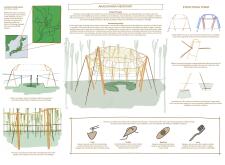5 key facts about this project
Innovative Use of Bamboo
A key aspect of the Arashiyama Viewpoint is its innovative use of bamboo, which is both a structural and decorative element within the design. The pavilion employs a tensegrity framework that utilizes bamboo struts combined with a tensioned cable system. This method minimizes material usage while maximizing structural efficiency, creating an open and airy environment. Unlike traditional wooden or steel pavilions, the tensioned design promotes a lightweight structure that harmonizes with the surrounding bamboo grove. This attention to materiality not only respects local resources but also emphasizes bamboo’s role in Japanese culture, demonstrating its adaptability in modern architecture.
Visitor Engagement and Educational Focus
The pavilion's design promotes visitor engagement through interactive elements. It includes designated areas for educational displays regarding bamboo's history, its diverse uses, and its ecological benefits. By incorporating these features, the project fosters a deeper understanding of the local environment among visitors. The circular observation space encourages immersive experiences, allowing guests to appreciate the bamboo forest from within an open framework. This direct interaction with nature distinguishes the Arashiyama Viewpoint from other architectural projects, as it combines functionality with educational outreach in a manner that is both intuitive and informative.
Overall, the Arashiyama Viewpoint embodies a thoughtful approach to architecture, emphasizing sustainability, community involvement, and cultural heritage. For further insights into the project, including architectural plans, sections, and design details, readers are encouraged to explore the project presentation.























